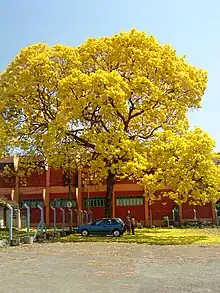| Tabebuia ochracea | |
|---|---|
 | |
| Scientific classification | |
| Kingdom: | Plantae |
| Clade: | Tracheophytes |
| Clade: | Angiosperms |
| Clade: | Eudicots |
| Clade: | Asterids |
| Order: | Lamiales |
| Family: | Bignoniaceae |
| Genus: | Tabebuia |
| Species: | T. ochracea |
| Binomial name | |
| Tabebuia ochracea | |
| Synonyms | |
|
Tabebuia hypodidiction | |
Tabebuia ochracea,[1][2] known as corteza amarillia in Spanish and ipê-amarelo in Portuguese, is a timber tree native to South America, Cerrado and Pantanal vegetation in Brazil. It is very similar, closely related to, and often confused with the Golden Trumpet Tree, Tabebuia chrysotricha. It is a seasonal flowering tree, blossoming only during spring (September). During this time, all leaves fall and only flowers remain in the crown.
There are three subspecies:
- Tabebuia ochracea ssp. heterotricha
- Tabebuia ochracea ssp. neochrysantha
- Tabebuia ochracea ssp. ochracea
Notes
References
- (in Portuguese) Lorenzi, Harri (1992) Árvores Brasileiras (Brazilian Trees) Nova Odessa: Plantarum. p. 52
- (in Portuguese) POTT, A. POTT, V.J. (1994) Plantas do Pantanal. (Plants of Pantanal) EMBRAPA ISBN 85-85007-36-2 p. 59
This article is issued from Wikipedia. The text is licensed under Creative Commons - Attribution - Sharealike. Additional terms may apply for the media files.